
When planning a trip, museums are the perfect addition to your itinerary. Museums help travelers explore the unique culture of locations and countries they visit through art, historical artifacts, clothing and other items. You can go to a museum to learn more about the places you visit or enjoy the beauty they offer. Many museums boast traveling exhibits, which encourage individuals to return for multiple visits.
Exploring a museum is enjoyable for many travelers. Knowing some of the best museums in the world can help you prepare for your next vacation.
In This Article
- Vatican Museums in Rome, Italy
- Tokyo National Museum in Tokyo, Japan
- Louvre Museum in Paris, France
- The Natural History Museum in London, England
- The Egyptian Museum in Cairo, Egypt
- The National Palace Museum in Taipei, Taiwan
- The State Hermitage Museum in St. Petersburg, Russia
- Museo Nacional de Antropología in Mexico City, Mexico
- Kunsthistorisches Museum Wien in Vienna, Austria
- Galleria degli Uffizi in Florence, Italy
- Musée d’Orsay in Paris, France
- The Van Gogh Museum in Amsterdam, Netherlands
- Museo de Arte Latinoamericano de Buenos Aires in Buenos Aires, Argentina
- Anne Frank House in Amsterdam, Netherlands
- The Acropolis Museum in Athens, Greece
- Explore the Most Famous Museums in the World With Windstar Cruises
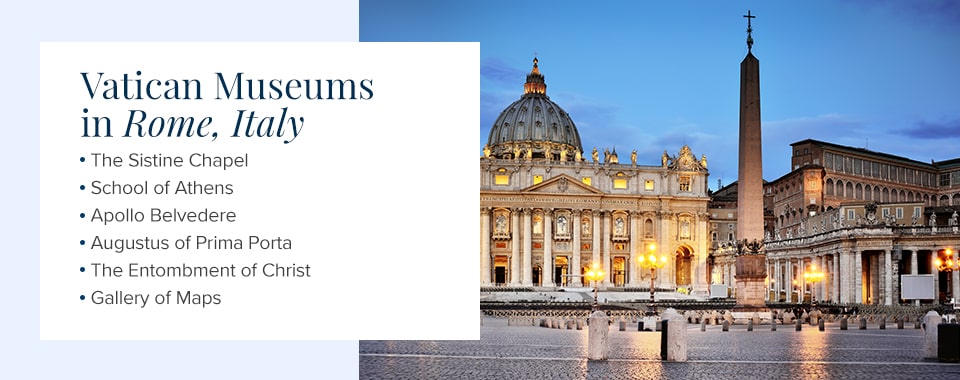
1. Vatican Museums in Rome, Italy
Located in the smallest country in the world, the Vatican Museums reside in Vatican City. These museums are a celebration of art, especially Classical and Renaissance art. When you visit the Vatican Museums, you can see art collected by various popes and the Catholic Church throughout history. The museums are all-encompassing, and it often takes hours to walk through and admire all the pieces. Overall, the Vatican Museums display around 20,000 paintings, sculptures, frescos and other artifacts and artworks.
Because they are so expansive, you might target some specific works of art when visiting the Vatican Museums. Some popular and iconic pieces housed here include:
- The Sistine Chapel: The Sistine Chapel is one of the most popular spots in the Vatican Museums because of its stunning original frescos completed by Michelangelo. The chapel walls and ceilings are complete with vibrant scenes from the Bible. On the ceiling, visitors can find the Creation of Adam, which depicts God giving life to the first man with an outstretched hand. The Last Judgement on the wall shows Michelangelo’s interpretation of the end of days.
- School of Athens: Painted by Renaissance master Raphael, the School of Athens is a fresco depicting several key Greek philosophers and mathematicians. Figures like Plato, Aristotle and Archimedes engage in discussion with other academics. This fresco displays the profound use of perspective developed in the Renaissance.
- Apollo Belvedere: The Apollo Belvedere marks one of the many Classical marble statues housed in the Vatican Museums. The statue depicts the Greek and Roman god Apollo with robes draped over his shoulder. From his majestic pose to the delicate folds of the fabric, this work highlights the ingenuity of Classical artists.
- Augustus of Prima Porta: While many Classical artists created works around mythical figures and stories, others used their medium to preserve critical political figures. Augustus of Prima Porta immortalizes Roman Emperor Augustus Caesar, highlighting his strength in defined muscles and a decorated breastplate.
- The Entombment of Christ: This painting represents one of the masterpieces of Caravaggio, a Renaissance and Baroque Italian painter known for his intensely human expressions and realism. In this work, mourners lay Christ’s body into a tomb, giving viewers a close-up look at their grief and sorrows.
- Gallery of Maps: Many of the halls of the Vatican Museums are art themselves. The Gallery of Maps is a long hall connecting galleries and chapels lined with detailed maps of Italy’s various regions. The vibrant blues and greens of the maps contrast beautifully against the ceiling’s gilded and ornate detailing.
The Vatican Museums are full of beautiful art and architecture. When in Rome, spend your time exploring the halls and discovering your new favorite work of art.
2. Tokyo National Museum in Tokyo, Japan
When visiting Japan, you must visit the Tokyo National Museum (TNM). This museum has around 600 works of art that cover several mediums, giving visitors diverse collections to explore. Here, you can find paintings, sculptures, calligraphy, ceramics and even armor. Because of its extensive collection, the TNM is actually several separate buildings, each with unique themes and focuses.
The TNM celebrates Japanese art and culture with its exhibits and artwork. Collections span several historical periods and display more modern works as well. Other exhibits showcase art from different countries and cultures, highlighting the diverse range of Asian art. Some topics and collections you can explore include the following:
- The tea ceremony: The tea ceremony in Japan is a culturally important occasion where individuals prepare matcha for tea. The collection celebrates this cultural event with various artifacts, like tea kettles, across different periods.
- Military attire: Japan has a long military history, with various warlords and samurai holding power. The military attire collections can bring you through this part of Japan’s history.
- Painted folded screens and sliding doors: Screen and sliding doors are more common in Japan, and many historical decorations involved painting scenes and patterns. This collection shows screens from various periods to highlight conventions and practices for a comprehensive understanding of the art style.
- Buddhist art: Buddhism is a widespread religion in Asia, spanning several countries. Statues and other imagery from various periods and cultures span several collections, highlighting the cultural significance of the Buddha and his teachings.
- Chinese calligraphy: While the tea ceremony is sacred in Japan, calligraphy of Chinese characters is an art form in China. These collections celebrate the study and work of masters in this discipline while encouraging visitors to appreciate the delicate forms.
The TNM also has many temporary and moving exhibits. Before visiting, you can optimize your visit to this museum by researching what each facility is currently offering. Its diverse collections and events can ensure you find something you will love.
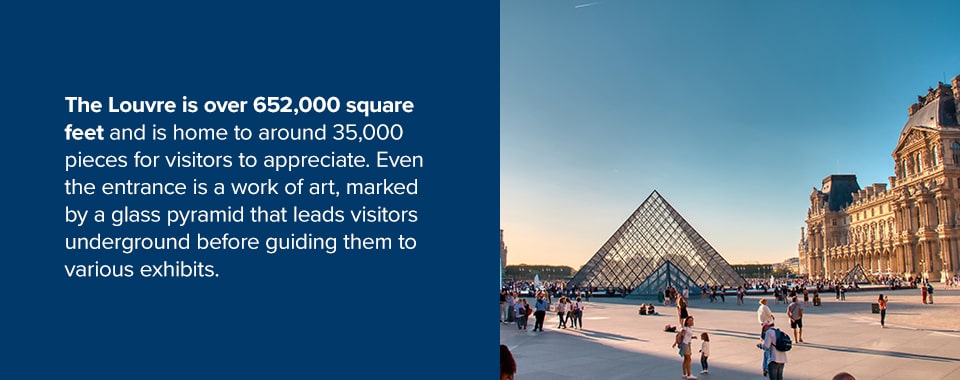
3. Louvre Museum in Paris, France
Like the Vatican Museums, the Louvre is another expansive collection with diverse exhibits complete with famous pieces. The Louvre is over 652,000 square feet and is home to around 35,000 pieces for visitors to appreciate. Even the entrance is a work of art, marked by a glass pyramid that leads visitors underground before guiding them to various exhibits.
Because the Louvre is so big, many visitors try to select what they want to see before. Some commonly sought artworks include:
- Mona Lisa by Leonardo da Vinci
- Venus de Milo by Alexandros of Antioch
- The Winged Victory of Samothrace
- Liberty Leading the People by Eugène Delacroix
- Psyche Revived by Cupid’s Kiss by Antonio Canova
- The Coronation of Napoleon by Jacques-Louis David
- The Virgin and Child with Saint Anne
- Portrait of Lous XIV by Hyacinthe Rigaud
- The Lacemaker by Johannes Vermeer
- Danseuse sur la scène by Edgar Degas
The Louvre keeps many beautiful French works, but you can find exhibits from around the world. A trip to the Louvre can transport you through time to appreciate ancient cultures with art and artifacts from Egypt, Asia, Greece, Rome and Islamic nations.
4. The Natural History Museum in London, England
London’s Natural History Museum formed after splitting from the British Museum. While the British Museum celebrates art and human accomplishments, this site focuses more on nature with five major collections:
- Botany
- Entomology
- Mineralogy
- Paleontology
- Zoology
Unlike other museums of the world that have art and artifacts, this museum mainly consists of specimens. For example, a blue whale skeleton hangs from the ceiling and is a major attraction in the museum.
The halls cater to different themes, each covering a different era of natural history and evolution. The Red Zone highlights the planet’s stages and phenomena, like volcanoes and earthquakes, while the Blue Zone uses specimens and taxidermy to show the different creatures living on the earth. You can find fossils, dinosaur skeletons and extinct animals scattered throughout the exhibits. A dodo skeleton gives visitors an idea of what the long-gone bird looked like.
Human evolution and life also play a significant role in the Natural History Museum’s exhibits and attractions. Collections and storage have Paleolithic and Neanderthal skulls, and the museum displays copies of rare and crucial scientific books.
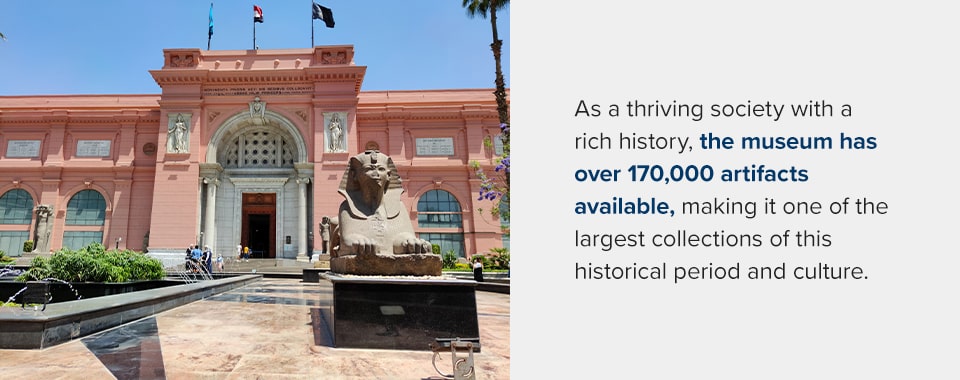
5. The Egyptian Museum in Cairo, Egypt
The Egyptian Museum in Cairo dedicates itself to housing and displaying ancient Egyptian artifacts and exhibits. As a thriving society with a rich history, the museum has over 170,000 artifacts available, making it one of the largest collections of this historical period and culture.
This museum has incredible diversity and showcases exciting exhibits full of interesting artifacts. Here, you can explore lavish jewelry worn by kings, statues of ancient Egyptian gods and leaders, stele with laws and stories, and sarcophagi of mummies and pharaohs with complex designs and laid with gold. One of the main attractions at this museum is the golden mask made for Tutenkahmen.
6. The National Palace Museum in Taipei, Taiwan
This museum in Taiwan represents centuries of Chinese history, expanding into the modern age. Many artifacts are from the palace in the Forbidden City in Beijing but moved south with the Republic of China during the Chinese Civil War.
The National Palace Museum has many categories of artifacts and art you can explore. In total, the museum boasts over 608,000 artifacts that span several dynasties and eras of history for a comprehensive glimpse at Chinese history. In display are several types of items, including:
- Paintings
- Calligraphy
- Ceramics
- Jade and bronze
- Rare books
Because the museum has such a comprehensive collection of Chinese artwork, curators and directors rotate pieces periodically in their permanent exhibitions, so visitors can frequently visit and see something new each time. This system allows the museum to share more of its collection with the public.
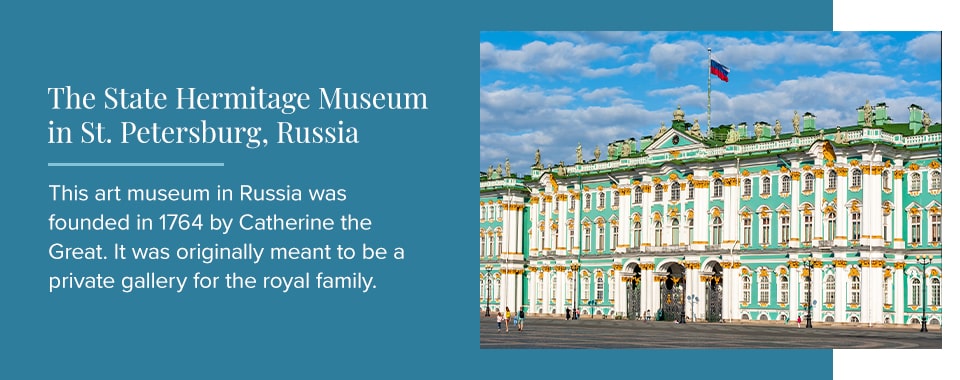
7. The State Hermitage Museum in St. Petersburg, Russia
This art museum in Russia was founded in 1764 by Catherine the Great. It was originally meant to be a private gallery for the royal family. It became public in 1852 after Tsar Nicholas I renovated it. Today, the museum spans five interconnected facilities and is home to more than 3 million artifacts and pieces of art, making it one of the largest museums in the world. The collections span history, starting with Prehistoric works and continuing through the modern age. You can find pieces from almost every era of art across cultures and continents.
8. Museo Nacional de Antropología in Mexico City, Mexico
The Museo Nacional de Antropología (MNA) hosts a collection of artifacts and art from before Christopher Columbus’s colonization. It includes many vital items from Mexico’s history, including:
- The Stone of Sun: Also known as the Aztec calendar or the Aztec sunstone, the original circular stone artwork is on display in the MNA. It tracks how the Aztec people measured time and people’s ages.
- Olmec colossal head: This statue represents the face of an unknown person from the Olmec civilization. The face has a distinct expression and features, setting it apart from others that archaeologists have discovered.
- Ball game goal: These circular stone features have holes in the center. Anthropologists believe people used these to toss balls into, giving insight into the games and pastimes of ancient American civilizations.
The exhibits also include many reproductions. Because the museum focuses on anthropological efforts and artifacts, replicas of tombs and statues allow archaeologists and anthropologists to continue studying items on sites and in labs while letting the public appreciate the art and cultural significance.
Besides its vast collection of art and history, many consider the museum’s design its own worthy exhibit. The museum contains several gardens complete with outdoor collections, spanning almost 45,000 square meters.

9. Kunsthistorisches Museum Wien in Vienna, Austria
This art museum sits in a palace-like complex topped with a dome for a regal flair. Inside, the dome has golden details and windows that let natural light fall into the hall. This art museum sports an impressive collection of paintings across artistic periods, as well as various sculptures and statues. Some key paintings that draw visitors to this gallery include the following:
- The Hunters in the Snow by Pieter Bruegel the Elder
- David with the Head of Goliath by Caravaggio
- Self-portrait by Rembrandt
- Infanta Margarita Teresa in a Blue Dress by Diego Velázquez
- Summer by Giuseppe Arcimboldo
- The Art of Painting by Johannes Vermeer
With work by many revered artists, this museum is great for art enthusiasts and historians. However, the collection’s historical and stylistic diversity makes it great for all visitors.
10. Galleria degli Uffizi in Florence, Italy
A couple of hours north of the Vatican Museums is the Galleria degli Uffizi in Florence. This Italian city is known for its love of the arts, mainly due to the legacy of the wealthy merchant Medici family, who created comprehensive collections with their personal riches. Today, visitors can explore the painting and sculpture galleries in this Italian museum. The work spans various art periods, from medieval religious imagery to Renaissance masterpieces.
The Galleria degli Uffizi is a comprehensive gallery with several famous pieces tucked into various rooms. Knowing what this museum offers can ensure you find everything. Some must-see artworks include:
- The Birth of Venus by Sandro Botticelli: This piece is one of Botticelli’s most famous works, depicting the Roman goddess of beauty and love stepping out of the ocean from a clamshell.
- Medusa by Caravaggio: Painted on the face of a shield, this work by Caravaggio shows Medusa’s head after being cut off by the Greek hero Perseus. Caravaggio captures the shock and anguish of the moment of her death, highlighting his work as a master.
- Judith Slaying Holofernes by Artemisia Gentileschi: This work is a rare masterpiece by a female artist. Gentileschi uses her mastery of the human form, expressions and color to depict Judith beheading a general with his sword to prevent a war.
When you want to explore the diversity and artistic skills the medieval and Renaissance Italian artists have to offer, this museum is perfect for you.
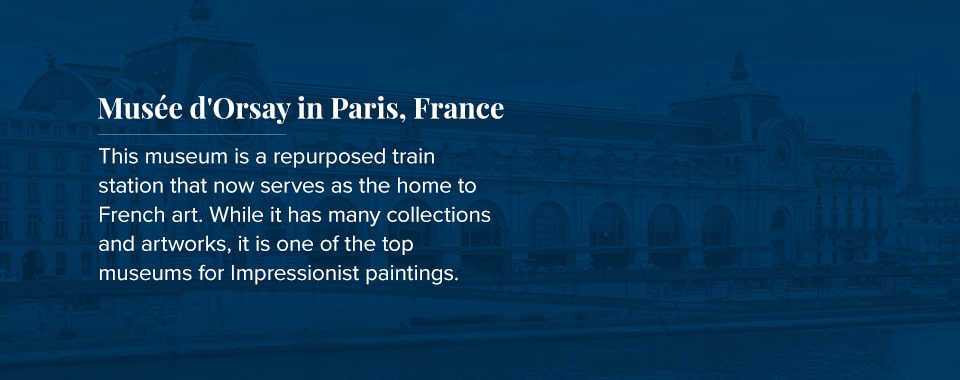
11. Musée d’Orsay in Paris, France
If the size of the Louvre is too overwhelming, Paris is home to many excellent art museums, including the Musée d’Orsay. This museum is a repurposed train station that now serves as the home to French art. While it has many collections and artworks, it is one of the top museums for Impressionist paintings. You can find works here by Monet, Degas, Renoir, Cézanne, Manet, van Gogh and others.
12. The Van Gogh Museum in Amsterdam, Netherlands
Vincent van Gogh’s use of color and movement in his paintings has made him one of the most recognized painters in the world. Many individuals know his masterpieces, Starry Night and Sunflowers. His letters with his younger brother, Theo, add more depth to his work, highlighting the financial and mental struggles of the young artist. The Van Gough Museum is one of many museums in Amsterdam dedicated to art, but it is a must-see for fans of this Impressionist artist.
The museum focuses on the artist’s art and life, displaying his paintings, sketches and letters. Its comprehensive sources thoroughly depict van Gogh’s life, from his youth to his early death. The museum hosts many commonly known works in its permanent collection, including the following:
- Van Gogh’s portraits
- Sunflowers
- Almond Blossoms
- Bedroom in Arles
- The Yellow House
- The Sower
- Wheatfield With Crows
The museum also contains works from other artists of the Impressionist movement and those inspired by van Gogh, so visitors can understand his legacy.
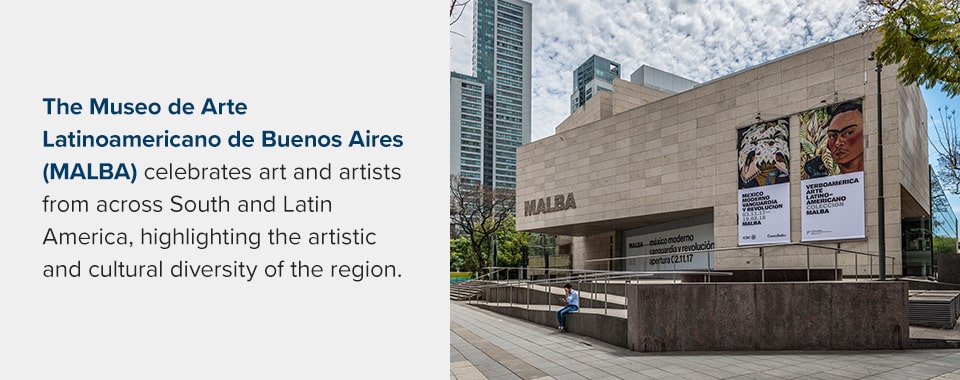
13. Museo de Arte Latinoamericano de Buenos Aires in Buenos Aires, Argentina
The Museo de Arte Latinoamericano de Buenos Aires (MALBA) celebrates art and artists from across South and Latin America, highlighting the artistic and cultural diversity of the region. This museum features work and art by well-known artists, including Diego Rivera, Frida Kahlo and Jorge de la Vega.
14. Anne Frank House in Amsterdam, Netherlands
While many museums focus on art, many stand to preserve history or moments in time. The Anne Frank House in Amsterdam allows visitors to step back in time to see the impact the Holocaust had on Jewish families. Here, you can walk through the annex where the Frank family and others spent their last days together. The original curators worked with Otto Frank, father to Anne, to maintain his family’s legacy.
Otto Frank requested that the annex remain exactly how it was when Nazi soldiers removed furniture and belongings after capturing the individuals living there. While the space is empty of furniture, visitors can still see the pictures Anne used to decorate the walls and the marks the family used to track her height.
The whole building is part of the museum. The rooms leading up to the annex describe the events leading to the Frank family going into hiding. You get to learn about the people living there and those who risked their lives to keep them hidden. After exiting the annex, visitors can see the aftermath of the Holocaust and the impact Anne’s diary had on the world.
Only a handful of museums offer an experience like the Anne Frank House. It brings an educational, emotional and personal lens to a devastating historical event. It is a humbling experience essential to anyone trying to understand the horrific impact of the Holocaust and the life of Anne Frank.
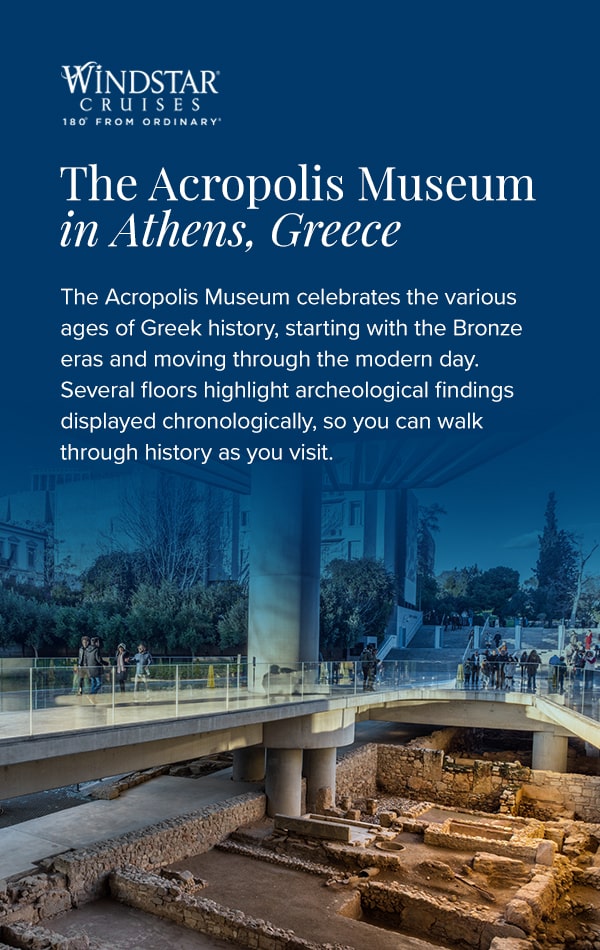
15. The Acropolis Museum in Athens, Greece
Athens attracts many individuals to its ancient Acropolis, allowing people to walk through the ruins and imagine what life was like for the ancient Athenians. After viewing the incredible temples and structures, you can head down the hill to learn more about the site’s archaeological findings at the Acropolis Museum.
The Acropolis Museum celebrates the various ages of Greek history, starting with the Bronze eras and moving through the modern day. Several floors highlight archeological findings displayed chronologically, so you can walk through history as you visit.
The top floor celebrates the Parthenon, the temple for the Greek goddess Athena. It houses many of the original marble statues and reliefs from the temple for better protection and viewing. The figures sit amongst columns arranged in the same layout as the original temple, helping visitors see what the Parthenon might have looked like in its prime. The glass walls let in natural light, so you can view it under more realistic conditions.

Explore the Most Famous Museums in the World With Windstar Cruises
When you want to discover and experience the best museums in the world, Windstar Cruises can help you reach your destination. On one of our intimate yachts, you will have a more personalized experience with staff who can take the time to know you and ships that can dock at more unique ports.
Find a cruise today, and discover how Windstar Cruises can lead you to your next adventure.





